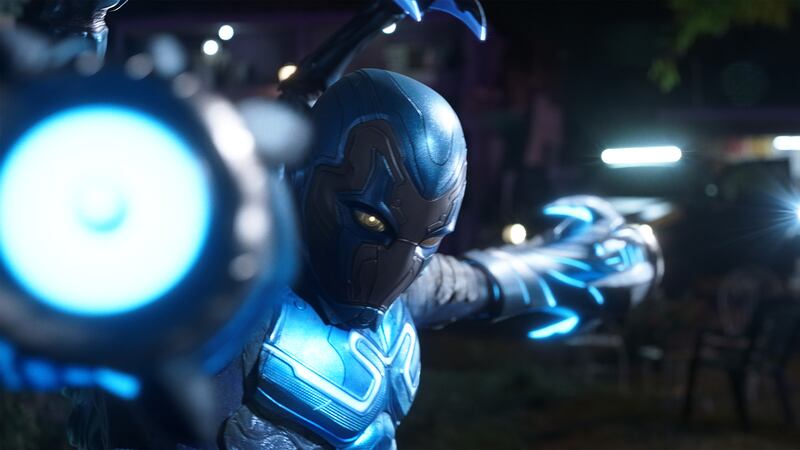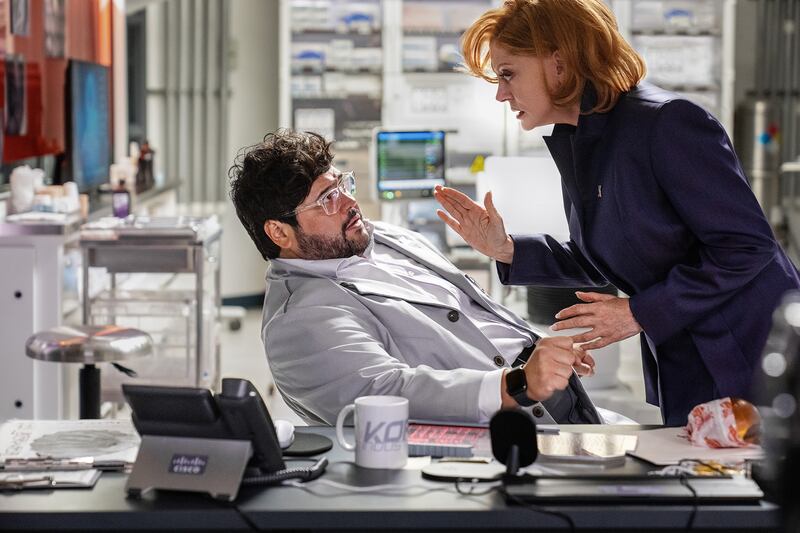Remember when a major superhero movie was an annual event? Me neither. Superhero movies have exploded more than any other genre in the 21st century, and by August we’d already had seven this year. Blue Beetle, the latest DC Comics movie (and the third DC movie this year), now makes eight. With two more on the way—November’s The Marvels and December’s Aquaman and the Lost Kingdom—we’re getting a whopping 10 superhero films in a single year.
No wonder people are exhausted, including myself. The thrill of seeing the latest superhero on screen has gone from a euphoric thrill to feeling like a chore. But something about Blue Beetle seemed different at first. Despite being around since the 1930s, Blue Beetle is a hero few are familiar with. DC also promised a Latino hero with its live-action take, making it an enticing project. And at its best, the film feels like a throwback to those early-2000s superhero movies like Spider-Man and X-Men that started the craze; it’s a charming origin story with humor and heart.
But Blue Beetle chucks all the goodwill it’s earned out the door in the final act, opting for an exhausting, CGI-fueled fight that lacks both stakes and cohesion. Blue Beetle falls prey to the all-too-common “third-act curse,” which has plagued many superhero movies of late: An attempt at a spectacular climax instead stops the film firmly in its quest on the way to be something special, right when it’s about to stick the landing.
(Warning: Spoilers ahead for Blue Beetle.)
The third-act curse is what I call the unfortunate, too-easy storytelling choice superhero movies make that effectively ruin the entire film. It’s become exhausting for fans to be able to guess the exact outcome of every superhero movie before we’ve even seen it. Every film follows the same storytelling trajectory: In the final act, the hero will battle their enemy, and look like they’re going to lose, before getting a miraculous second wind and saving the day, followed by an uplifting wrap-up before the credits roll. This third-act curse is all but guaranteed to turn any promising movie into a bore, with Blue Beetle as this narrative trapping’s latest victim.
It’s not that every superhero movie has to end with the hero losing the fight and possibly even dying—that would be terrible for business, and it would likely cause a riotous reaction on social media like we’ve never seen before. I’m also not even against having an epic final battle in the third act. Superheroes fight! That’s kind of their thing. Plus, familiarity is comforting, and comfort is a big part of what makes the genre such a major success.
But of all the superhero movie clichés (some welcome, others less so), the third-act curse is by far the easiest trap filmmakers fall into to derail their movie, stopping the film dead in its tracks. That’s not so much a problem when the film is already terrible—and for DC movies, that’s an all-too-regular occurrence. When movies like Wonder Woman 1984, Suicide Squad, and Justice League (pre-Snyder cut) default to lifeless CGI blowouts over meaningful character development, we’re already bored out of our minds anyway, so we don’t even notice the nosedive in quality.

Blue Beetle, however, is bursting with promise, which makes its falling prey to the third-act curse all the more disappointing. Xolo Maridueña (of Cobra Kai fame) is wonderful in the lead role of Jaime/Blue Beetle, bursting with energy and excitement. What really makes the film feel unique in the superhero landscape is its focus on family. The film begins with Jaime returning to his father Alberto (Damián Alcázar), sister Milagro (Belissa Escobedo), mother Rocio (Elpidia Carrillo), uncle Rudy (George Lopez), and Nana (Adriana Barraza), and the film is at its best when exploring this Latin-American family dynamic.
Especially exciting is how Jaime’s family becomes an integral part of Blue Beetle’s plot. While superhero origins are often shrouded in mystery, forcing heroes to live a life of secrecy, terrified of the consequences of being discovered, Jaime’s family is present when he turns into the Blue Beetle. It’s a hysterical, delightful moment full of chaos and panic that shows how special Blue Beetle can be, when it focuses on the family element—which it does well, until the final act.
The third act starts off well enough. Jaime and his family head to an island to put an end to the plans of Victoria Kord (Susan Sarandon, who seems exhausted with every line reading) and her One Man Army Corps (OMAC) project. A family banding together to take down an evil corporation? That’s a fresh and exciting idea, even if the evil corporation aspect is as tired as it’s ever been.
But then the family splits up, which leads to most of the film spending time on corporate mumbo jumbo and CGI-fueled fights. Instead of being engaged by the generic (and occasionally ugly) action, I found myself wondering where these lovable characters had gone. Even more frustrating is that when Jaime’s family briefly appears again—Nana taking down a number of assailants with a giant machine gun and shouting “Down with the imperialists” is the film’s best moment—they vanish again without a trace.
All of this happens so Blue Beetle can get to the moment everyone (read: no one) has been waiting for—the final battle between Jaime and Carapax (Raoul Max Trujillo), Victoria’s bodyguard turned cyborg, who’s meant to lead the OMACs. In this lengthy fight, the fantastic family dynamic that made Blue Beetle feel special is thrown by the wayside for the equivalent of two machines hurling themselves at each other and going “pew pew.” Worse still is that both Maridueña and Trujillo are completely obscured by their costumes/robotics during the fight, which leads it to feel particularly impersonal. It doesn’t help either that Carapax is as generic a villain as they come.
Both Marvel and DC movies have struggled to make their villains feel substantial, but Blue Beetle reaches a new low by making the third-act climax take place between Jaime and a composite collection of muscles. There’s absolutely nothing to Carapax; when we see him swing wildly at Jaime, we have no idea why he’s so determined to win the fight, other than that he’s been programmed that way. There’s no reason to even consider rooting for Carapax, which makes the fight entirely one-sided, and totally boring.
Many DC movies have opted to go a darker route, so a brutal slugfest between enemies would make sense. But Blue Beetle leans so heavily into the comedic aspect until that last battle that it feels woefully out of place here. It could have been fantastic to see the film take a risk and really go all out in the final fight—instead of a villain we know absolutely nothing about and has no discernable personality of any kind, why not challenge our expectations and turn Victoria into a bloodthirsty mech-human hybrid? Not a soul on Earth would have seen that coming, and it would have lent heavily into both the family aspect (Victoria is the aunt of Jenny, Jaime’s love interest, played by Bruna Marquezine) and the comedy. Instead of playing into a tired trope, the third act could have been invigorating.
What’s bizarre is that we finally understand more about both Carapax after the fight. When Jaime officially has the upper hand, he’s prepared to break his solemn rule not to kill and terminate Carapax. It’s then that Khaji Da (Becky G, the mysterious voice of the scarab that’s bonded with Jaime) finally tells us Carapax’s history. What a waste! If it happened earlier, we may have had a reason to care about the seemingly endless swathe of time we spent watching these two duke it out. Instead, we’ve been cursed with one of the most purposeless, stakes-free, emotionless, and unoriginal battles in DC movie history. And worst of all, it ruins the movie.

Not every superhero film has fallen to the third-act curse—even those that do end the film with an extensive fight scene. Birds of Prey bursts with creative choreography and delightful bursts of color, fully leaning into the comedy of its concept as its cast massacred every enemy in sight. And The Suicide Squad blended serious and silly to perfection as the crew took down a gigantic starfish. On the Marvel side, the first Guardians of the Galaxy did the completely unexpected, turning its climactic final fight into a dance party. It bodes well for the future of DC Comics movies that two of these were helmed by James Gunn, as he and co-exec Peter Safran work to reboot the DC Universe. Hopefully, we’ve seen the last of the dreaded third-act curse—but Blue Beetle doesn’t offer much hope that we’re done with it completely.






